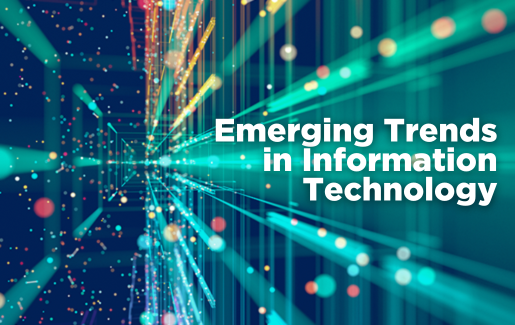 Every year, new technologies emerge that provide innovative approaches to business challenges and life’s problems. Some of these stand the test of time and others fall by the wayside, leaving room for new technological developments and startups to join the race. It can be difficult to know which emerging tech is worth the investment and which you should pass over. This list will give you a better understanding of technology trends that will last into the next generation and real-world use cases you can expect to see in 2023 and beyond.
Every year, new technologies emerge that provide innovative approaches to business challenges and life’s problems. Some of these stand the test of time and others fall by the wayside, leaving room for new technological developments and startups to join the race. It can be difficult to know which emerging tech is worth the investment and which you should pass over. This list will give you a better understanding of technology trends that will last into the next generation and real-world use cases you can expect to see in 2023 and beyond.
Related: Download the infographic now.
1. Artificial Intelligence (AI)
Artificial Intelligence continues to rank at the top of emerging tech. Chatbots and Apple’s Siri are common examples of AI in action, but we will see more complex versions being used in the near future.
Trend: Generative AI and increased focus on explainable AI and ethical considerations
Generative AI is taking us one step closer to what we’ve always seen from cinematic tech of the future. ChatGPT, a generative AI technology that utilizes natural language processing and can generate text based on a prompt, caused quite a stir upon its release in November 2022 as leaders evaluated the impact of the technology on business applications, but also tried to anticipate the ethical implications of a technology that can mimic human output. Largely, how can we determine if copy came from people or technology?
Explainable AI is a subset of artificial intelligence and is the next step in our technology journey, where the technology provides logic and reasoning for why it came to a conclusion. Previously, even the developers of AI often couldn’t explain how achieved a particular outcome. Explainable AI provides an outcome and how it got there.
Use Cases
- Improve issue resolution times in customer service
- Enhanced marketing automation through focused advertising and social media reach
- Develop routine software code
2. Internet of Things (IoT)
Internet of Things (IoT) uses connected devices, such as wearables and sensors, to provide more optimal results for businesses.
Trend: Expansion of IoT devices in various industries and increased focus on cybersecurity
IoT devices are becoming increasingly used across various industries. A large part of this expansion derives from the increasing bandwidths we are seeing with 5G. Running parallel to that expansion is the need for increased cybersecurity, particularly with respect to IoT. The open interconnectivity capabilities of IoT have made it a prime candidate for cyberattacks in the past. Providers will refocus their efforts to help ensure IoT is becoming more secure.
Use Cases
- More options for autonomous transportation
- Monitoring of buildings and the environment for optimized energy usage and identification of harmful conditions
- Improved fleet management
- Better healthcare monitoring and improved patient outcomes
3. Machine Learning (ML)
Machine learning has helped technology advance significantly in recent years, giving us the ability to draw insights from massive amounts of data.
Trend: Continued development of automated machine learning (AutoML)
While machine learning has offered us many applications in the near past, the major breakthrough in machine learning will involve automated machine learning. Machine learning, while valuable, is highly resource intensive and consumes a ton of time to develop the learning models. With AutoML, many of the iterative and mundane tasks, such as data cleansing and parameter selection, are automated to reduce the burden on technical resources. Using algorithms rather than humans to build learning models, AutoML also allows non-technical people to make better use of the technology.
Use Cases
- Enhanced document and text classification, allowing for better identification of information
- Improved accuracy and speed of data management
- Fast fraud detection
4. 5G Networks
5G networks have been key for increasing speeds, increasing capacity and reducing latency. The next wave of networks will involve 5G networks that stand alone.
Trend: Development of standalone 5G networks for broader coverage and lower latency
When 5G networks originally rolled out, they were dependent on the 4G core network to provide data transfer and coverage. This allowed for the initial functionality without implementing a whole new infrastructure. Now, with the development of 5G standalone (5G SA) networks, users will have access to greater coverage and will experience lower latency. Utilizing a cloud-based architecture, 5G SA will provide a better user experience and pave the way for technologies such as autonomous vehicle automation and precision robotics.
Use Cases
- Reliable remote control of machinery, robotics and other devices
- Secure, controlled and widespread internet access unlimited by geography
- More accurate inventory management across all industries
5. Edge Computing
According to Deloitte, U.S. households have an average of 22 connected devices. Edge computing may well be the answer to managing big data.
Trend: Growth of edge computing in various industries, including healthcare and manufacturing
The sheer number of devices being used on a regular basis is staggering and the amount of data that is created is astronomical in size. If all that data had to cross a network and be processed in a data center, users would see very low latency and long wait times for data analysis and insights. Edge computing allows this data to be processed closer to the point of creation to minimize the latency and increase speeds. The introduction of more devices in the healthcare and manufacturing fields is causing the adoption of edge computing to help improve patient outcomes and reduce delays in supply chain processes.
Use Cases
- Reducing latency in IoT
- Connecting medical devices and in-hospital monitoring
- Optimization of content delivery networks (CDNs)
6. Blockchain
Blockchain is helping to keep data more secure and creating a reliable history of transactions. The applications extend far beyond that of cryptocurrency.
Trend: Increased adoption in supply chain management and financial services
The rise in supply chain issues and the increased digitization of currency is creating new use cases for blockchain. With its indelible transaction history, blockchain is helping to give real-time insight into the tracking of goods from creation to distribution, relieving some of the bottlenecks that are created in the supply chain. In financial services, blockchain is now being applied to streamline banking and lending in the face of digitization and reducing operational risks with verified history.
Use Cases
- Improved supply chain tracking and management
- Better protection of intellectual property
- Secure peer-to-peer transactions
7. Spatial Computing
Spatial computing is making huge strides and improving how we interact with the digital world. Be prepared for the technology of the future.
Trend: The next step in merging physical and digital worlds after VR and AR
Spatial computing is a complex technology that involves how people interact with digital content. Using a variety of sensors, cameras and other connected technology, spatial computing uses 3D interfaces to allow users to create and manipulate content in their physical space. Think Tony Stark and how he uses the space around him to interact with his technology. Spatial computing will take us so much farther than VR and AR, allowing us to apply technology to help shape our very existence.
Use Cases
- Enhance virtual education, business meetings, remote assistance and other collaborative activities
- Deliver greater design visualization
- Create immersive advertising and marketing campaigns
8. Smart Spaces
Smart spaces will be increasingly used to help optimize different areas.
Trend: The use of AI and IoT technologies to create more intelligent and responsive environments
Smart spaces use advanced, connected technologies to help monitor a space, provide information about the area and increase efficiency in that environment. The collection of data allows people to make informed decisions about the safety and condition of the location, while allowing for refined usage of that space. Smart spaces will involve a variety of connected sensors to automate management of that area, including such tasks as adjusting lighting and temperature.
Use Cases
- Better utilization of energy consumption
- Efficient use of building space and occupancy
- Improved management of health and safety in spaces
9. Homomorphic Encryption
Security concerns make data encryption a necessary task, but the encryption/decryption process can be time intensive. Homomorphic encryption changes all that.
Trend: Advancements in secure data privacy solutions that allow computation on encrypted data without decryption
Homomorphic encryption allows for data processing without first having to decrypt the information. This is valuable because it enhances data security without interrupting business processes. This will have a huge impact on privacy and compliance as businesses utilize homomorphic encryption to maintain data integrity while sharing the information with all required parties.
Use Cases
- Secure transfer of financial, personal or sensitive information or communications
- Increase the integrity of the voting process
- Allow for the development of secure machine learning models
10. Metaverse
The metaverse is a term that is gaining traction as more interactions take place in digital spaces. The metaverse is expected to take us beyond simple simulations into a more advanced digital world.
Trend: The creation of a shared virtual space where people can interact in a three-dimensional environment
The metaverse is an emerging technology that would function as a shared, immersive digital space which can be accessed through augmented reality devices. Ideally, the metaverse would allow for more connected interactions in a virtual space that go beyond our current virtual-reality capabilities. The application of the metaverse would ideally allow for more life-like interaction and better idea sharing without the need for physical proximity.
Use Cases
- Allow for immersive virtual events
- Enhance the quality of remote learning
- Tour real estate properties without being physically present
11. 3D Printing and Additive Manufacturing
The value provided by 3D printers has already been proven, with advances being made in many different industries. As we continue to see expanded applications, 3D printing continues to provide more possibilities for business.
Trend: Expansion of 3D printing materials and applications, including metal and ceramic printing and use of 3D printing in mass production
3D printing has the potential to help eliminate huge amounts of waste in mass production. In addition, metal and ceramic printing are adding to the myriad uses for additive manufacturing, expanding beyond the use cases of plastic-only 3D printing. The expansion of materials is helping to optimize manufacturing processes while reducing material and machinery costs.
Use Cases
- Development of resilient and bone-like medical implants
- Cheaper and faster production of aerospace components
12. Smart Homes and Cities
Smart homes and cities have put the benefits of IoT to use to benefit families and residents.
Trend: Increased adoption of Internet of Things (IoT) devices in homes and cities, allowing for greater automation and connectivity
Smart homes and cities will allow for efficiency at scale, with more connectivity options to bring together homes and even entire cities. Smart homes and cities can maximize energy usage, while helping to increase the safety of public spaces, reduce bottlenecks in transportation and public services, create greater sustainability practices and make use of forms of renewable energy.
Use Cases
- Optimized occupancy in residential and business buildings
- Efficient energy storage and usage across spaces
- Enhance monitoring and safety of public spaces
13. Robotics and Automation
Expanded applications for robotics and automation will sooner offer new and exciting ways to innovate.
Trend: Development of more sophisticated robots with advanced sensing capabilities and increased focus on robot-human collaboration
Robotics will soon allow for better interactions between humans and robots. Technological advances in the field and recent prototypes demonstrate heightened interactions between robots and their surroundings, with improved capabilities of interacting with their surrounding environment. These breakthroughs will enable greater safety, increased automation and enhanced efficiency.
Use Cases
- Automated manufacturing and quality assurance
- Expanded space exploration
- Eliminate employee dangers in the workplace
For more emerging technology use cases, check out
CompTIA's From Promise to Profit series on YouTube.

 Add CompTIA to your favorite RSS reader
Add CompTIA to your favorite RSS reader

